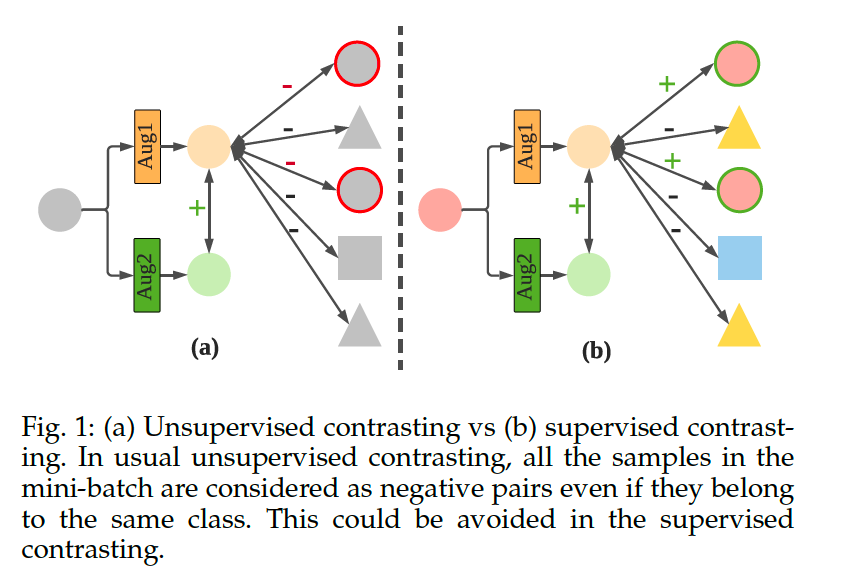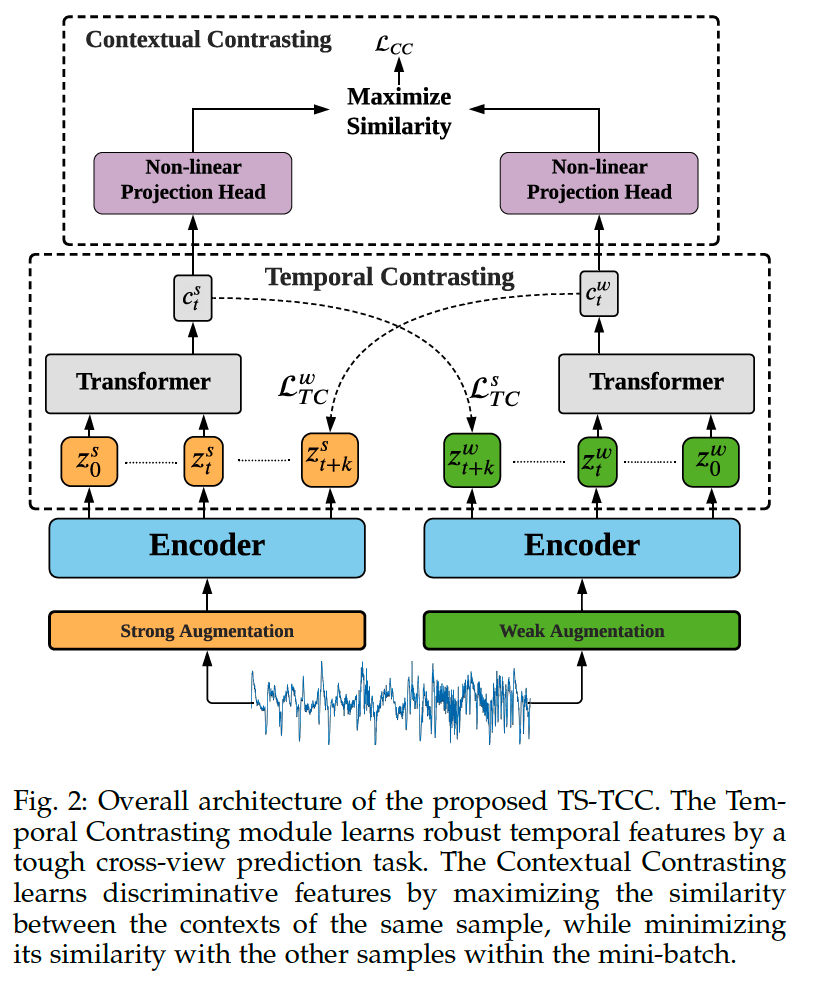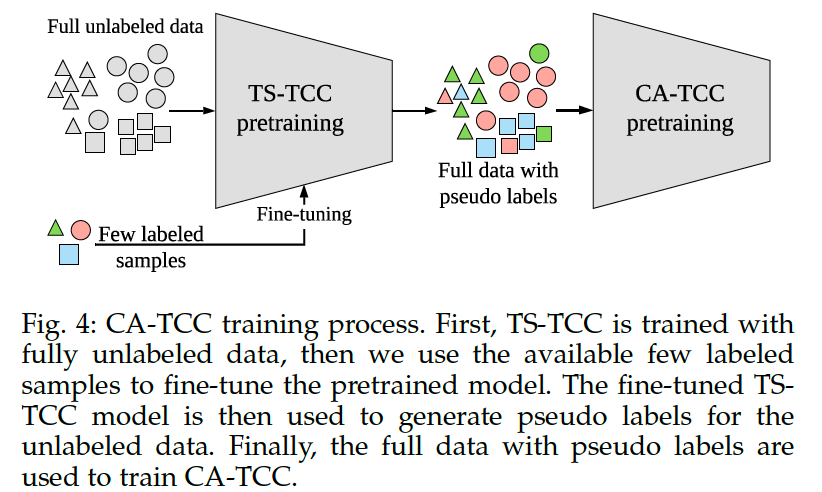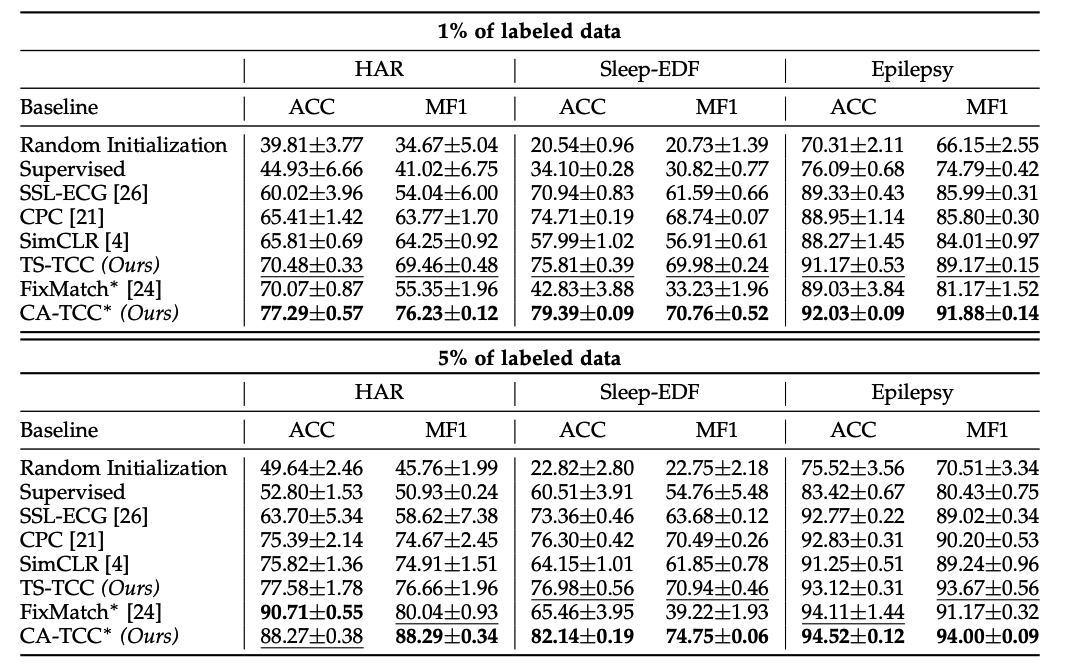Self-supervised Contrastive Representation Learning for Semi-supervised TSC
Contents
- Abstract
- Introduction
- SSL for TS
- Pretext Tasks
- Contrastive Learning
- Methods
- TS Data Augmentation
- Temporal Contrasting
- Contextual Contrasting
- Class-Aware TS-TCC
- Experiments
0. Abstract
propose a novel TS representation learning framework
- with TS-TCC ( Temporal and Contextual Contrasting )
- use contrastive learning
propose time-series specific ”weak” and “strong” augmentations
& use their views to
- learn “robust temporal relations” in the proposed temporal contrasting module
- learn “discriminative representations” by our proposed contextual contrasting module
Details
-
conduct a systematic study of time-series data augmentation selection
-
extend TS-TCC to the semi-supervised learning sestings
\(\rightarrow\) propose a Class-Aware TS-TCC (CA-TCC)
- benefits from the available few labeled data
- leverage robust pseudo labels produced by TS-TCC to realize class-aware contrastive loss.
1. Introduction
Contrastive learning
- strong ability over pretext tasks
- ability to learn invariant representations by contrasting different views of the input sample ( via augmentation )
image-based contrastive learning methods
- may not able to work on TS
Why?
- reason 1) where its features are mostly spatial, we find time-series data are mainly characterised by the temporal dependencies
- reason 2) augmentation techniques used for images such as color distortion, generally cannot fit well with TS data
Proposal
- propose a novel framework, that incorporates contrastive learning into self- and semi-supervised learning
- propose a Time-Series representation learning framework via Temporal and Contextual
Contrasting (TS-TCC), that is trained on totally unlabeled datasets
- employs 2 contrastive learning & augmentation techniques
- propose simple yet efficient data augmentations
- that can fit any TS to create 2 different, but correlated views of the input samples
- then used by the 2 innovative contrastive learning modules
- (module 1) temporal contrasting module
- learn robust representations by designing a tough cross-view prediction task
- (module 2) contextual contrasting module
- learn discriminative representations
- aim to maximize the similarity among different contexts of the same sample while minimizing similarity among contexts of different samples
Limitation of the contextual contrasting :
-
contrasting samples from the same class will be treated as negative pairs
( since label information is not available )
-
propose another variant for Class-Aware TS-TCC (CA-TCC) to utilize class information when contrasting between samples

2. SSL for TS
(1) Pretext Tasks
- ex) [25] binary classification pretext task for HAR
- by applying several transformations
- classify between the original &transformed
- ex) [26] SSL-ECG
- ECG representations are learned by applying 6 transformations
- assigned pseudo labels according to the transformation type
- classify these transformations
- ex) [27] designed 8 auxiliary tasks
- ex) [28] subject-invariant representations by modeling local and global activity patterns
(2) Contrastive Learning
-
ex) CPC ( Contrastive Predictive Coding )
- by predicting the future in the latent space
- great advances in various speech recognition
-
ex) [29] : studied 3 self-supervised tasks with 2 pretext tasks & 1 contrastive task
- pretext 1) relative positioning
- pretext 2) temporal shuffling
- contrastive 1) uses CPC to learn representations about clinical EEG data
\(\rightarrow\) representations learned by CPC perform the best
\(\rightarrow\) CL generally perform better than the pretext tasks
-
ex) [9] : designed EEG related augmentations & extended SimCLR
Existing approaches : use either TEMPORAL or GLOBAL features
\(\leftrightarrow\) proposed : address both types of features
- in our (1) cross-view temporal and (2) contextual contrasting modules.
3. Methods
Preliminaries : TS-TCC
Starting with TS-TCC
-
step 1) generate 2 different yet correlated views of the input data
- based on strong and weak augmentations
-
step 2) temporal contrasting module
-
explore the temporal features of the data with 2 autoregressive models
-
perform a tough cross-view prediction task,
by predicting the future of one view using the past of the other
-
-
step 3) contextual contrasting module
- maximize the agreement between the contexts of the AR models

(1) TS Data Augmentation
Data augmentation
-
key part in the success of the contrastive learning
-
Usually, contrastive learning methods use 2 (random) variants of the same augmentation
However, we argue that producing views from DIFFERENT augmentations can improve the robustness of the learned representations
\(\rightarrow\) propose 2 separate augmentations
- ver 1) weak
- ver 2) strong
Strong & Weak augmentation
strong augmentation
- to enable the tough cross-view prediction task in the next module
- helps in learning robust representations
weak augmentation
- aims to add some small variations to the signal without affecting its characteristics
Notation
- input : \(x\)
- strong & weak sample : \(x^s \sim \mathcal{T}_s\) and \(x^w \sim \mathcal{T}_w\)
- then passed to the encoder
- Encoder : \(\mathbf{z}=f_{e n c}(\mathbf{x})\)
- 3 block convolutional architecture
- Encoded : \(\mathbf{z}=\left[z_1, z_2, \ldots z_T\right]\)
- where \(T\) is the total timesteps, \(z_i \in \mathbb{R}^d\), where \(d\) is the feature length
- Encoded ( weak & strong ) : \(\mathbf{z}^s\) & \(\mathbf{z}^w\)
- then fed into the temporal contrasting module
(2) Temporal Contrasting
- deploys a contrastive loss to extract temporal features
- with an AR model ( \(f_{\text {ar }}\) )
- generates context vector : \(c_t=f_{a r}\left(\mathbf{z}_{\leq t}\right), c_t \in \mathbb{R}^h\)
- \(h\) is the hidden dimension of \(f_{a r}\)
- \(c_t\) is then used to predict the timesteps from \(z_{t+1}\) until \(z_{t+k}(1<k \leq K)\)
- use log-bilinear model … \(f_k\left(x_{t+k}, c_t\right)=\exp \left(\left(\mathcal{W}_k\left(c_t\right)\right)^T z_{t+k}\right)\)
- generates context vector : \(c_t=f_{a r}\left(\mathbf{z}_{\leq t}\right), c_t \in \mathbb{R}^h\)
- strong & weak
- strong augmentation : generates \(c_t^s\)
- weak augmentation : generates \(c_t^w\)
- propose a tough cross-view prediction task
- use \(c_t^s\) to predict future timesteps of \(z_{t+k}^w\)
- use \(c_t^w\) to predict future timesteps of \(z_{t+k}^s\)
-
contrastive loss :
\( \begin{gathered} \mathcal{L}_{T C}^s=-\frac{1}{K} \sum_{k=1}^K \log \frac{\exp \left(\left(\mathcal{W}_k\left(c_t^s\right)\right)^T z_{t+k}^w\right)}{\sum_{n \in \mathcal{N}_{t, k}} \exp \left(\left(\mathcal{W}_k\left(c_t^s\right)\right)^T z_n^w\right)} \\ \mathcal{L}_{T C}^w=-\frac{1}{K} \sum_{k=1}^K \log \frac{\exp\left(\left(\mathcal{W}_k\left(c_t^w\right)\right)^T z_{t+k}^s\right)}{\sum_{n \in \mathcal{N}_{t, k}} \exp \left(\left(\mathcal{W}_k\left(c_t^w\right)\right)^T z_n^s\right)}\end{gathered}\).
Transformer

- use Transformer as the AR model
- mainly consists of multi-headed attention (MHA) followed by a Multilayer Perceptron (MLP)
- MLP : 2 FC layer + ReLU + dropout
- use Pre-norm residual connections
- stack \(L\) identical layers to generate the final features
- add a token \(c \in \mathbb{R}^h\) to the input
- acts as a representative context vector in the output
Procedures
- step 1) linear projection
- apply \(\mathbf{z}_{\leq t}\) to a linear projection \(\mathcal{W}_{\text {Tran }}: \mathbb{R}^{d \rightarrow h}\)
- maps the features into the hidden dimension
- step 2) sent to the Transformer
- \(\tilde{\mathbf{z}}=\mathcal{W}_{\operatorname{Tran}}(\mathbf{z}_{\leq t}), \quad \tilde{\mathbf{z}} \in \mathbb{R}^h\).
- step 3) attach the context vector into the feature vector \(\tilde{\mathbf{z}}\)
- input features become \(\psi_0=[c ; \tilde{\mathbf{z}}]\)
- step 4) pass \(\psi_0\) through Transformer layers
- \(\tilde{\psi}_l =\operatorname{MHA}\left(\operatorname{Norm}\left(\psi_{l-1}\right)\right)+\psi_{l-1}, 1 \leq l \leq L\).
- \(\psi_l =\operatorname{MLP}\left(\operatorname{Norm}\left(\tilde{\psi}_l\right)\right)+\tilde{\psi}_l,1 \leq l \leq L\).
- step 5) re-attach the context vector from the final output
- \(c_t=\psi_L^0\) ….. be the input of the contextual contrasting module
(3) Contextual Contrasting
aims to learn more discriminative representations
Procedures
-
step 1) apply a non-linear transformation to the contexts
-
via projection head
- maps the contexts into the space where the contextual contrasting is applied
-
ex) given a batch of N input samples … will have 2 contexts for each sample
\(\rightarrow\) Have \(2N\) contexts
-
Notation ) for context \(c_t^i\) ….
- positive sample : \(c_t^{i^{+}}\)
- positive pair : \(\left(c_t^i, c_t^{i^{+}}\right)\)
- negative samples : remaining \((2 N-2)\) contexts
-
-
step 2) Contextual Contrasting Loss ( \(\mathcal{L}_{C C}\) )
- \(\begin{aligned} &\ell\left(i, i^{+}\right)=-\log \frac{\exp\left(\operatorname{sim}\left(c_t^i, c_t^{i+}\right) / \tau\right)}{\sum_{m=1}^{2 N} \mathbb{1}_{[m \neq i]} \exp \left(\operatorname{sim}\left(c_t^i, c_t^m\right) / \tau\right)} \\&\mathcal{L}_{C C}=\frac{1}{2 N} \sum_{k=1}^{2 N}[\ell(2 k-1,2 k)+\ell(2 k, 2 k-1)]\end{aligned}\).
- \(\operatorname{sim}(\boldsymbol{u}, \boldsymbol{v})=\boldsymbol{u}^T \boldsymbol{v} / \mid \mid \boldsymbol{u} \mid \mid \mid \mid \boldsymbol{v} \mid \mid\).
- \(\begin{aligned} &\ell\left(i, i^{+}\right)=-\log \frac{\exp\left(\operatorname{sim}\left(c_t^i, c_t^{i+}\right) / \tau\right)}{\sum_{m=1}^{2 N} \mathbb{1}_{[m \neq i]} \exp \left(\operatorname{sim}\left(c_t^i, c_t^m\right) / \tau\right)} \\&\mathcal{L}_{C C}=\frac{1}{2 N} \sum_{k=1}^{2 N}[\ell(2 k-1,2 k)+\ell(2 k, 2 k-1)]\end{aligned}\).
-
step 3) Overall SSL Loss :
- (1) temporal contrasting loss
- (2) contextual contrasting loss
\(\rightarrow\) \(\mathcal{L}_{\text {unsup }}=\lambda_1 \cdot\left(\mathcal{L}_{T C}^s+\mathcal{L}_{T C}^w\right)+\lambda_2 \cdot \mathcal{L}_{C C}\)
(4) Class-Aware TS-TCC
second variant of our framework :
-
use of few labeled data
( to further improve the representation learned by TS-TCC )
-
aim to overcome one drawback in the contextual contrasting module : considering all the samples in mini-batch as negative pairs
-
solution : CA TCC
CA TCC ( Class-Aware TS-TCC )
- replace the contextual contrasting with a ”supervised” contextual contrasting
Supervised contrastive learning
- first proposed to improve the supervised CE loss
- reuse it in our framework to improve the contextual contrasting
- instead of having a single positive pair (from augmented views), we use multiple instances from the same class as positive pairs
BUT … requires the availability of the “full” labeled data
\(\rightarrow\) in CATCC, make use of the available “few” labeled samples to fine-tune the pretrained TS-TCC.
-
then, fine-tuned model is used to generate pseudo labels for the unlabeled data
& use these pseudo labels to train our CA-TCC

Notation
- \(N\) labeled samples \(\left\{\mathbf{x}_k, y_k\right\}_{k=1 \ldots N}\)
- after augmentations) \(2 N\) samples, \(\left\{\hat{\mathbf{x}}_l, \hat{y}_l\right\}_{l=1 \ldots 2 N}\)
- such that \(\hat{\mathbf{x}}_{2 k}\) and \(\hat{\mathbf{x}}_{2 k-1}\) are the two views of \(\mathbf{x}_k\)
- \(y_k=\hat{y}_{2 k}=\hat{y}_{2 k-1}\).
- \(A(i) \equiv I \backslash\{i\}\),
- supervised contextual contrasting loss
- \(\mathcal{L}_{S C C}=\sum_{i \in I} \frac{1}{ \mid P(i) \mid } \sum_{p \in P(i)} \ell(i, p)\).
- \(P(i)=\left\{p \in A(i): \hat{y}_p=\hat{y}_i\right\}\) : indices of all samples with same class as \(\hat{\mathbf{x}}_i\) in a batch
- \(\mid P(i) \mid\) : cardinality of \(P(i)\)
- \(\mathcal{L}_{S C C}=\sum_{i \in I} \frac{1}{ \mid P(i) \mid } \sum_{p \in P(i)} \ell(i, p)\).
Overall Loss :
- \(\mathcal{L}_{\text {semi }}=\lambda_3 \cdot\left(\mathcal{L}_{T C}^s+\mathcal{L}_{T C}^w\right)+\lambda_4 \cdot \mathcal{L}_{S C C}\).
4. Experiments
Evaluate on 3 different training settings
- (1) linear evaluation
- (2) semi-supervised training
- (3) transfer learning
2 metrics
- (1) accuracy
- (2) macro-averaged F1-score (MF1)
- for imbalanced datasets
(1) Comparison with Baselines
Baselines
- (1) Random Initialization:
- training a linear classifier on top of frozen and randomly initialized encoder
- (2) Supervised:
- supervised training of both encoder and classifier
- (3) SSL-ECG
- (4) CPC
- (5) SimCLR
- use our timeseries specific augmentations to pretrain SimCLR
- (6) FixMatch
- relies on weak and strong augmentations in training
- trained it using our proposed augmentations
To evaluate the performance of SSL-ECG, CPC, SimCLR and TS-TCC ….
- step 1) pretrain ( w.o labeled data )
- step 2) evaluation ( with a portion of the labeled data )
- standard linear evaluation scheme
- train a linear classifier on top of a frozen SSL pretrained encoder model
Accuracy ( with LIMITED labeled dataset )

Implications
- contrastive methods > pretext-based method
- contrastive methods : CPC, SimCLR and our TS-TCC
- pretext-based method : SSL-ECG
- CPC > SimCLR
- temporal features are more important than general features in TS data
(2) Semi-supervised Experiments
investigate TS-TCC, under different semi-supervised settings
- fine-tune the pretrained model using 1%, 5%, 10%, 50%, 75% data
- metric : MF1 ( \(\because\) imbalance of Sleep-EDF )

(3) Transfer Learning
Dataset : Fault Diagnosis (FD)
- has 4 working conditions ( = 4 domains, A/B/C/D )
Process
- step 1) train the model on the data from one condition (i.e., source domain)
- step 2) test it on another condition (i.e., target domain)
3 training schemes on the source domain
- (1) Supervised training
- (2) TS-TCC fine-tuning
- (3) CATCC fine-tuning
(2) TS-TCC fine-tuning & (3) CA-TCC fine-tuning
- fine-tune our pretrained encoder using the labeled data in the source domain

